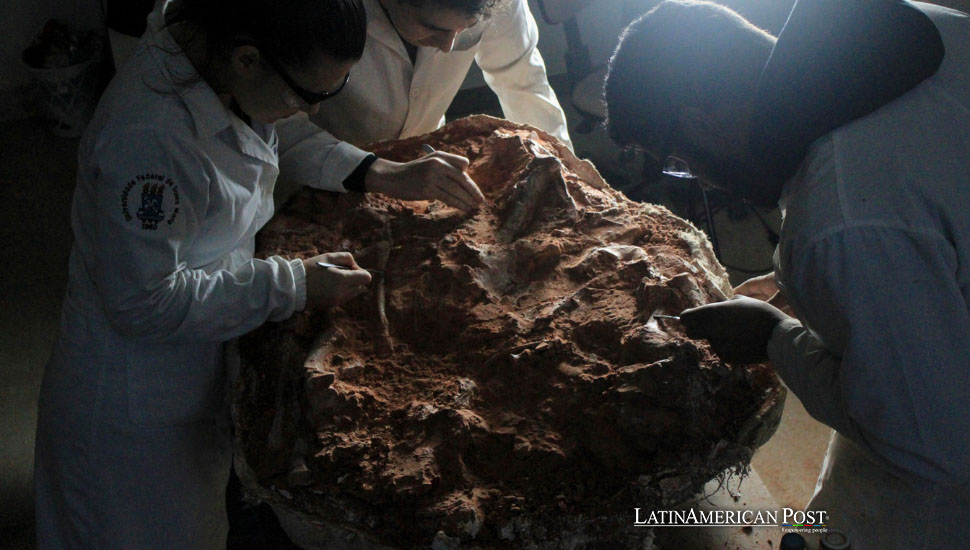Discovery of Ancient Dinosaur Fossil in Brazil Sparks Scientific Excitement

A team of Brazilian scientists has unearthed one of the world’s oldest dinosaur skeletons in Rio Grande do Sul. The fossil, believed to be around 233 million years old, could offer new insights into the origins of dinosaurs.
In a remarkable discovery, a team of Brazilian scientists has uncovered a fossilized skeleton of what they believe to be one of the oldest dinosaurs ever found. The fossil was discovered in the southern state of Rio Grande do Sul after heavy rains accelerated the natural process of erosion, revealing the ancient bones next to a reservoir in the municipality of São João do Polêsine. The team, led by paleontologist Rodrigo Temp Müller from the Federal University of Santa Maria, found the bones in May and analyzed them eagerly.
According to Müller, the dinosaur lived during the Triassic period, around 233 million years ago, when all continents were part of a single landmass, Pangaea. This era is significant because it marks when dinosaurs first began to evolve. The apex predator discovered in Rio Grande do Sul belongs to the Herrerasauridae family, a group of dinosaurs that once roamed the areas that are now Brazil and Argentina.
The fossilized remains suggest that the dinosaur would have reached approximately 2.5 meters (8.2 feet) in length. Müller and his team were thrilled to find such a well-preserved specimen. “Initially, it seemed like just a few isolated bones, but as we exposed the material, we could see that we had an almost complete skeleton,” Müller explained. The discovery is believed to be the second most complete skeleton, providing an extraordinary opportunity to study these ancient creatures.
A Race Against Time: Climate and Preservation
The heavy rains that revealed the fossil also highlight the urgent need to preserve such finds. The Rio Grande do Sul experienced record rainfall earlier this year, leading to devastating floods that killed at least 182 people in May, according to the state’s civil defense. These extreme weather events, exacerbated by climate change, have made unearthing and preserving fossils more challenging. As rainwater washes away sediment, it exposes fossils and can cause significant damage.
Müller noted that more fossils will likely appear due to these weather conditions, creating a race against time to rescue the materials before they are ruined. In the field, his team observed that the rain was already destroying some bones. “We saw a leg bone and a pelvis bone in the pelvic region that were already being damaged,” he said. This discovery, therefore, not only offers a glimpse into the distant past but also underscores the impact of present-day environmental changes on archaeological research.
The discovery of this ancient dinosaur skeleton is expected to contribute significantly to understanding dinosaur origins. The detailed study of such well-preserved fossils helps scientists piece together the evolutionary history of these magnificent creatures. Researchers are now tasked with determining whether the fossil belongs to an already-known species or represents a new kind. This meticulous process will take several months, as careful examination is required to ensure no damage is caused to the specimen.
The phenomenon known as weathering, where water removes the sediment covering fossils, has played a crucial role in revealing these ancient remains. However, it also poses a threat to their preservation. The record rainfall amounts in Rio Grande do Sul have created opportunities and challenges for paleontologists. The race to uncover and study these fossils before natural elements destroy them is a pressing concern for scientists like Müller.
The Significance of the Discovery of Latin America
This groundbreaking find in Brazil adds a new chapter to Latin America’s rich paleontological history. The region is known for its diverse and abundant fossil records, which provide invaluable insights into prehistoric life. The discovery of the Herrerasauridae dinosaur in Rio Grande do Sul reinforces Latin America’s importance in understanding the early evolution of dinosaurs.
Such discoveries also highlight the need for continued investment in the region’s scientific research and preservation efforts. The collaboration between local scientists and international experts is crucial for advancing knowledge and protecting these priceless archaeological treasures. The Brazilian team’s work exemplifies the dedication and expertise required to contribute significantly to science.
The discovery has sparked excitement not only among the scientific community but also among the general public. It serves as a reminder of the incredible history hidden beneath our feet and the continuous efforts needed to uncover and preserve it. As scientists work to study and understand these ancient creatures, they inspire future generations to appreciate and protect the natural world.
Looking ahead, the discovery of the Herrerasauridae dinosaur skeleton in Brazil opens new avenues for research and exploration. As Müller and his team continue their meticulous work, they hope to uncover more details about this ancient predator and its environment. The information gathered from this fossil will add to the growing body of knowledge about the Triassic period and the early evolution of dinosaurs.
The researchers’ findings will eventually be published in scientific journals, allowing the broader scientific community to scrutinize and build upon their work. This peer-reviewed process is essential for validating the discovery and integrating it into the larger framework of paleontological research. The team’s initial excitement and surprise at finding such a well-preserved skeleton underscore the potential for more groundbreaking discoveries in the future.
The ongoing research will also likely involve advanced technologies such as CT scanning and 3D modeling, which can provide deeper insights into the fossil’s structure and characteristics. These technologies enable scientists to study the fossil in greater detail without causing damage, offering new perspectives on the anatomy and biology of ancient dinosaurs.
A Landmark Discovery for Science and History
The discovery of one of the world’s oldest dinosaur skeletons in Brazil is a landmark event in paleontology. It sheds light on the early evolution of dinosaurs and underscores the importance of preserving our natural heritage. As climate change continues to impact the environment, the urgency of protecting and studying such finds becomes ever more critical.
This discovery is a testament to the dedication and expertise of Brazilian scientists and highlights the significant role that Latin America plays in uncovering the mysteries of our planet’s past. As researchers continue to study and analyze the fossil, they will undoubtedly contribute valuable insights that enhance our understanding of prehistoric life.
Also read: IATA Challenges Brazil on High Jet Fuel Costs, Seeks Change
The journey from the initial discovery to the detailed analysis and eventual publication of findings is rigorous and meticulous. It reflects the broader efforts of the scientific community to explore, understand, and preserve the natural world. The discovery of the Herrerasauridae dinosaur skeleton reminds us of the wonders beneath the surface and the ongoing quest to uncover the secrets of our planet’s history.





